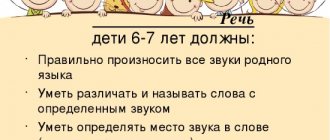Article:
OSD is a general underdevelopment of speech.
This disorder affects all aspects of the child’s speech, that is, its sound, lexical, grammatical, and semantic components. Manifestations of OHP depend on the insufficient development of various components of the speech apparatus. They can vary from complete absence of speech to speech, with elements of phonetic, lexical and grammatical underdevelopment. This disease is detected by a special diagnosis by a speech therapist. The correction program and its features are established individually by the attending physician. Among all children with speech disorders, children with ODD make up about 40%. Its strong and profound manifestations may in the future manifest themselves as dysgraphia and dyslexia. Speech therapists use the term phonetic-phonemic development or FFN and OHP to designate the immaturity of the speech system. OHP in children can be observed in the presence of dysarthria, alalia and other disorders.
Classification
According to the clinical picture of manifestations of ONR, it is divided into three groups:
- Uncomplicated form. Such children have minimal brain dysfunction, insufficient regulation of muscle tone, and immature volitional and emotional spheres.
- Complicated form. Occurs in patients with a number of neurological or psychopathic diseases, convulsive, cerebrasthenic and others.
- Gross underdevelopment. Children have lesions in the speech areas of the brain, that is, in the presence of alalia and dysarthria.
OHP also has its own degrees of severity. There are four in total:
- first degree - speechless, with the absence of commonly used speech;
- second degree – there are basic elements of common speech, poor vocabulary, agrammatism;
- third – the presence of phrasal speech, with underdevelopment of sound and semantic components;
- fourth degree – some problems in the phonetic-phonemic and lexical-grammatical aspects of speech.
Depending on the degree of complexity, the duration of correctional work of OHP by a speech therapist is determined.
Characteristics of degrees
Each degree of OSD has a certain relationship between primary and secondary speech defects, which inhibit the formation of its components. The transition from one level to another is determined by the presence of new speech capabilities and changes in its activity. The most persistent manifestations of OHP are observed with motor alalia, and less often with stuttering or rhinolalia. There are only four degrees of OHP.
ONR first degree
This disorder is characterized by a complete absence of speech, and this degree is detected immediately. It manifests itself in the following:
- Vocabulary is extremely limited. For communication, the simplest babbling words, fragments of words, syllables or onomatopoeia are used. At the same time, the baby loves to communicate, but speaks with the people around him in “his own” language. That is, the child has in his speech such words as “woof-woof”, “meow-meow”, “too-too” and the like.
- A preschooler with the first degree of OHP actively uses appropriate facial expressions and gestures and carry a semantic load. The child uses these techniques to express himself, and the adult makes every effort to understand them.
- Speech does not contain sentences or phrases consisting of several words. Only individual amorphous words with a general meaning are observed, for example, the phrase “woof-woof tu-tu” means that the dog rode the train.
- Passive vocabulary significantly exceeds active one. The baby understands speech addressed to him, but is unable to say anything.
- Words with complex composition and structure are kept to a minimum, long complex words are simply abbreviated, but their meaning can be understood. For example, the word bus may sound like abus, or tube.
ONR second degree
OHP type 2 differs from the first degree in the presence in the child’s speech of a small number of commonly used words; they may not be pronounced quite correctly. The beginning of the formation of connections between words may also be noticeable, but this is still on an unstable basis. The following symptoms are typical for grade 2 OHP:
- The child uses one word that denotes an object or some action, but in a modified form. For example, the word "bus" will sound like "abous" in any context.
- The active vocabulary is very limited; with OHP 2, they do not know all the words denoting some characteristics of an object, for example, a description of its shape, color and other characteristics.
- The child does not have the skill to combine objects into certain semantic groups, for example, tableware - spoon, fork, plate.
- The pronunciation of many sounds, words, and phrases is impaired.
Also, characteristic features of type 2 OHP are the presence of rudiments of grammatical changes depending on the complexity of the word itself. The more letters there are in a word, the more mistakes and violations the child makes in it. He actively uses words in his speech, but does not coordinate them with each other. This is how the phrases “mama kupa” appear - “mom is bathing. Thus, prepositions are simply missed or used incorrectly. The patient can make up a short story based on the picture shown and the active assistance of the parent. However, this story turns out to be extremely modest. Usually two or three syllable sentences are used. In OHP 2, the words themselves are greatly distorted, and the pronunciation of words with a polysyllabic structure is impaired.
OHP third degree
This degree is characterized by a delay in the grammatical and phonetic speech components. The child has active expressive speech and is able to construct individual phrases and has a fairly large vocabulary. The problem points of speech are:
- communicates only with parents, with other people only with a “translator”;
- sound pronunciation is not fully formed;
- in independent speech, sounds may sound incorrect;
- more complex sounds are replaced by simple ones;
- has difficulty with hissing, whistling and sonorant sounds;
- one and the same sound can replace several;
- The vocabulary is expanding, but only a small part of it is used.
Grammar is also impaired in grade 3 OHP, but the child tries to construct complex sentences, but difficulties arise with their pronunciation. The child may not formulate sentences correctly, but can create a short story. Another distinctive feature is inconsistent grammatical errors, that is, in one sentence the same error is made, but not in another phrase. The baby may lag behind in his phonetic abilities, manifested in the so-called difficult words. All these factors delay the process of preparing a child for school.
OHP fourth degree
This degree is characterized by the presence of only some difficulties and errors in speech. This creates an overall picture that prevents you from fully mastering speech, sound understanding and pronunciation. The main thing for parents in this case is to contact speech therapy specialists in order to correct all existing deficiencies as quickly as possible. Characteristic signs of OHP type 4 are:
- there are no obvious violations of sound pronunciation, the sounds themselves are delivered correctly;
- speech is slurred with unclear, blurred sound pronunciation;
- there are violations of the structure of syllables, expressed in the replacement of sounds with similar ones;
- incorrect use of certain words denoting characteristics of a particular object;
- the child may not understand or confuse the phrases “long table” and “high table”;
- difficulties in choosing the correct suffixes;
- Agrammatisms may occur, but their number is minimal.
Violations characteristic of level 4 OHP are not so common. Speech is characterized by criticality, and the grammatical structure itself is close to its norm.
Characteristics of children
To obtain a conclusion from a doctor and a referral for primary medical care, a child must draw up a profile. A speech therapist or teacher may suggest that a preschooler has general speech underdevelopment; to confirm the diagnosis, it is necessary to examine the child in the relaxed atmosphere of a kindergarten or in classes with a specialist.
When compiling a specification, pay attention to the following points:
- History, heredity. A survey of parents and analysis of records in the child’s outpatient record will be required.
- Anatomical structure of the speech apparatus.
- Level of development of motor skills (fine, gross), determine the leading hand.
- Intelligibility, coherence of speech, its understandability to others.
- Level of understanding of someone else's speech.
- The presence of defects in sound pronunciation.
- Level of vocabulary development (active and passive).
- Features of the grammatical structure of speech.
An example of a characteristics of a preschool child compiled for presentation at the PMPK.
Novikova Irina, 5 years old. Attends preschool educational institution No. 4 in Oryol. Speech disorders were not observed in parents in childhood. The family is complete and socially prosperous. The girl was born full-term, weight 3400, height 53 cm, no congenital diseases, somatically healthy.
Organs of the articulatory apparatus without anatomical features. When performing articulation exercises, breathing becomes difficult, the muscles of the tip of the tongue work weakly.
Speech is slurred, quiet, unexpressive, and not always understandable to others. Understanding someone else's speech is normal.
Sound pronunciation is difficult due to parasigmatism of sibilants and rhotacism. In isolation, pronounces almost all sounds correctly. Omission and simplification of syllables are noted.
Vocabulary is average, passive predominates over active. Has difficulty selecting synonyms, describing objects, and confuses prepositions. In speech he uses simple phrases and sentences of 3-4 words; there are numerous errors in coordination and word formation.
An examination of Irina’s speech showed that the disorders correspond to the signs of grade 3 ODD.
Reasons for OHP
The causes of OHP are mainly problems during pregnancy or childbirth, as well as in the first years of the baby’s life. The most basic reasons for OHP:
- infectious diseases of the mother during pregnancy;
- toxicosis;
- birth injury;
- asphyxia, hypoxia;
- incompatibility of mother and child by Rh factor;
- disorders in the central nervous system;
- head injuries of a baby in his first years of life;
- the influence of nicotine, alcohol, drugs;
- deprivation.
Social reasons are also important. This may be due to insufficient communication with the child. Often this form of OHP occurs in children living with their parents who have hearing problems. The attention of adults to it has a noticeable effect on speech skills and should be given a lot of time.
Pathogenesis
OHP should be considered as a systemic disorder that affects language subsystems, that is:
- phonetic-phonemic;
- grammar;
- lexical;
- semantics.
Level 1 OHP in a child causes him to lag behind accepted age norms. This happens across the entire spectrum of indicators, both quantitative and qualitative. Such children have disturbances in the general course of speech development, the timing, and the order in which they master articulatory skills. Experts compare general speech development with linguistic infantility.
The very mechanism of the appearance and development of general speech impairment has a close connection with primary speech defects and their direct causes. In the presence of disorders of cerebral-organic origin, such as alalia or aphasia, severe speech disorder may occur, as well as misunderstanding of the speech of others.
Thus, speech pronunciation and its perception suffer. If there are anatomical defects, insufficient development of the speech apparatus, the syllabic structure of words disintegrates, and the lexical and grammatical basis of statements is disrupted.
Reasons, first signs
Often, speech problems that determine the level of speech development are predetermined even before the birth of the child due to genetic predisposition or complications during pregnancy. The most common reasons for the development of general speech underdevelopment include:
- Rh conflict between the child and the mother;
- intrauterine strangulation of the fetus, hypoxia;
- injuries caused during childbirth;
- persistent infectious diseases in infancy;
- traumatic brain injuries;
- chronic diseases.
Reasons of a psycho-emotional and mental nature include shock of any nature, place of residence or conditions unsuitable for the development of communication skills, lack of verbal communication, and attention.
Typically, the onset of the disorder can be diagnosed at a fairly late age. The development of OHP may be indicated by a prolonged absence of speech in a child (mostly by 3–5 years). In the presence of speech activity, its activity and diversity are not high; often spoken words are illegible and illiterate.
The concentration of attention may be reduced, the processes of perception and memorization may be inhibited. In some cases, there is a violation of motor activity (especially related to coordination of movements) and hidden motor skills of pronunciation.
Often, general underdevelopment of level 3 speech is mistakenly identified with delayed speech development. These are different deviations: in the first case, there is a pathology of speech reflection of thoughts, in the second - the untimeliness of the appearance of speech while maintaining its clarity and literacy.
Diagnostics
The diagnosis of onr can only be made by conducting a comprehensive study. Diagnosis is carried out at an initial consultation with a speech therapist. The specialist establishes contact with the child, the parents must have medical reports from a neurologist, pediatrician, and the results of the studies. Having received all available information, the specialist studies and determines the speech status of his patient.
Speech therapy research is carried out in two stages - orientation and language examination. The orientation is carried out through a conversation with parents. This way, all the features of the course of the disease are clarified, what reasons accompanied it, and how the speech apparatus developed. The patient himself is also assessed - his ability to make contact, articulatory motor skills.
When examining the language and its components, the formation of speech, its coherence, grammar, and vocabulary are determined. In the case of the presence of OHP of the first degree, there is a gross underdevelopment of all components of the language system, which is explained by the child’s lack of commonly used speech. After this, the specialist can draw up his conclusion and establish the clinical form of the pathology of the speech apparatus.
It is important to distinguish insufficient speech development from other forms, such as speechlessness, autism, mental disabilities, hearing impairments, etc.
Recommended speech therapy examination
It is worth studying in detail the vocabulary of a person suffering from OPD. This will allow you to assess the ability to correlate a word with a specific subject. This is done in several steps:
- Selection of material, divided into individual lexical topics. This determines the child’s ability to communicate with the people around him.
- Pictures with objects are offered.
- Pictures with names of body parts are used.
- Selection of synonyms for the selected word.
During the diagnosis, the speech therapist must give his conclusion, which indicates the level of speech development, the clinical picture, the degree of OHP, and also draw up a plan for correcting the identified disorders.
Diagnostic measures
To make an accurate diagnosis and identify the causes of speech underdevelopment, the child is examined in three stages. Initially, a pediatrician and a neurologist work with the children, who conduct a physical examination and examine brain functions using additional research methods: electroencephalography, magnetic resonance imaging, etc.
At the second stage of the examination, a child psychologist is involved in diagnosis. Its task is to assess the degree of development of cognitive and mental skills and to characterize the child’s personality. The third stage of diagnosis takes place with a speech therapist, who examines various aspects of speech skills: lexico-grammatical, phonetic, phonemic, syllabic structure and coherence of speech.
A speech therapy study is most important if the conclusions of doctors and psychologists do not reveal possible organic causes for the development of OHP. During the examination, specialists must establish the specific degree of speech development disorder in order to select effective treatment.
Parents should take an active part in correcting the child’s speech skills, since a speech therapist can communicate with him a limited amount of time per week. Communication in the family and active interaction with children allow them to accelerate the formation of correct speech.
Correction of the disorder
Corrective work on OHP should only be carried out by a qualified specialist. Preschool children with the first degree of speech impairment attend special speech therapy groups in kindergarten. They must enter here at the age of 3-4 years, and the classes themselves are conducted in groups, subgroups and individually. The purpose of correction is to transfer the child to another stage of speech development, to compensate for all existing deviations.
This work is carried out simultaneously in various directions:
- Speech understanding. This problem can be better solved by conducting classes in a playful way. The child must find toys that the specialist names for him, show the correct pictures, expand his vocabulary, and master the pronunciation of phrases, phrases, and multi-word phrases.
- Speech activation. Development of onomatopoeia in a child, for example, the voices of various animals, musical instruments. This stimulates his speech activity. Pronouns, verbs, and addressing an adult are gradually introduced into speech.
- Non-speech development. Correct speech is impossible without the development of auxiliary mechanisms - concentration, development of thinking, memory. Much attention should be paid to the intellectual and mental development of the child. Auxiliary techniques include logorhythmics, speech therapy massage, development of fine motor skills and articulation.
At the last stage, sound pronunciation must be performed with correct grammar and speech format. Treatment of second-degree ODD includes the development of the child’s speech skills, his understanding of adult speech, and training of the lexical and grammatical component. At the third degree, coherent semantic speech is formed, vocabulary and grammar are improved, and correct articulation is consolidated. A lot of time should be devoted to mastering the necessary literacy.
For children with SEN IV, it is important to achieve their age-specific speech standards, which is necessary for successful studies at school. Schoolchildren with severe forms of ODD are trained in schools created to work with children with speech disorders. Here the emphasis is on compensation for all aspects of the manifestation of speech underdevelopment1.
Characteristics of children at the 3rd level of speech development; consultation on speech therapy (senior group) on the topic
Characteristics of children with III level of speech development
This level of children's speech development is characterized by the presence of extensive phrasal speech with pronounced elements of underdevelopment of vocabulary, grammar and phonetics.
It is typical to use simple common sentences, as well as some types of complex sentences. The structure of sentences can be disrupted by omitting or rearranging the main and minor members, for example: “the trim is moving and is not recognized” - the squirrel looks and does not recognize (the hare); “There’s smoke coming out of the pipe, potamutsh hbydna”—smoke is pouring out of the pipe in a column because it’s cold. In children's statements, words appear consisting of; of three to five syllables (“akvaiyum” - aquarium, “tatal-list” - tractor driver, “vadapavod” - water pipe, “zadi-nut” - lighter).
Special tasks make it possible to identify significant difficulties in the use of some simple and most complex prepositions, in the agreement of nouns with adjectives and numerals in indirect cases (“took from the yasik” - took from the box, “tli vedela” - three buckets, “the boat climbs under the chair” - the box is lying under the chair, “there is no barbed stick” - there is no brown stick, “the lamastel is scratching, mowing with a bow” - writing with a felt-tip pen, painting with a pen, “it’s lying from here” - taken from the table, etc.). Thus, the formation of the grammatical structure of language in children at this level is incomplete and is still characterized by the presence of pronounced violations of coordination and control.
An important feature of a child’s speech is the insufficient development of word-formation activity. In their own speech, children use simple diminutive forms of nouns, individual possessive and relative adjectives, names of some professions, prefixed verbs, etc., corresponding to the most productive and frequent word-formation models (“tail - tail, nose - spout, teaches - teacher , plays hockey - a hockey player, chicken soup - chicken, etc."). At the same time, they do not yet have sufficient cognitive speech capabilities to adequately explain the meanings of these words (“switch” - “turns on the light”, “vineyard” - “he plants”, “stove-maker” - “stove”, etc.). ) - Persistent and severe violations are observed when trying to form words that go beyond the scope of everyday speech practice. Thus, children often replace the operation of word formation with word inflection (instead of “hand” - “hands”, instead of “sparrow” - “sparrows”, etc.) or completely refuse to transform the word, replacing it with a situational statement (instead of “cyclist” - “ who rides a bicycle", instead of "sage" - "who is smart, he thinks everything"). In cases where children do resort to word-formation operations, their utterances are replete with specific speech errors, such as: violations in the choice of the productive stem (“builds houses - houseman”, “ski poles - poles”), omissions and replacements of word-formation affixes (“tractoril - tractor driver, chytik - reader, abriksnyn - apricot”, etc.), gross distortion of the sound-syllable structure of the derived word (“svintsovyy - svitenby, svitsoy”), the desire for a mechanical connection within the word of the root and affix ( "pea - pea", "fur - fur", etc.). A typical manifestation of general underdevelopment of speech at this level is the difficulty of transferring word-formation skills to new speech material.
These children are characterized by an inaccurate understanding and use of generalizing concepts, words with abstract and figurative meanings (instead of “clothes” - “coats”, “kofnichki” - blouses, “furniture” - “various stems”, “dishes” - “bowls”), ignorance of the names of words that go beyond the scope of everyday everyday communication: parts of the human body (elbow, bridge of the nose, nostrils, eyelids), animals (hooves, udder, mane, tusks), names of professions (machinist, ballerina, carpenter, joiner) and actions related with them (drives, performs, saws, chops, planes), inaccuracy in the use of words to designate animals, birds, fish, insects (rhinoceros - “cow”, giraffe - “big horse”, woodpecker, nightingale - “bird”, pike, catfish - “fish”, spider - “fly”, caterpillar - “worm”), etc. There is a tendency towards multiple lexical substitutions of various types: confusion based on external similarity, substitution based on the value of the functional load, species-generic confusion, substitutions within one associative field, etc. (“dishes” - “bowl”, “hole” - “hole”), “saucepan” - “bowl”, “dive” - “swimmed”).
Along with lexical errors, children with the third level of speech development also have a specific uniqueness of coherent speech. Its lack of development often manifests itself both in children's dialogues and monologues. This is confirmed by the difficulties of programming the content of extended statements and their linguistic design. Characteristic features of coherent speech are a violation of the coherence and sequence of the story, semantic omissions of essential elements of the storyline, noticeable fragmentation of the presentation, violation of temporal and cause-and-effect relationships in the text. These specific features are due to the low degree of independent speech activity of the child, with the inability to identify the main and secondary elements of his plan and the connections between them, with the impossibility of clearly constructing an integral composition of the text. At the same time as these errors, the poverty and monotony of the language used is noted. Thus, when talking about their favorite toys or events from their own lives, children mostly use short, uninformative phrases. When constructing sentences, they omit or rearrange individual parts of the sentence and replace complex prepositions with simple ones. Often there is an incorrect design of word connections within a phrase and a violation of interphrase connections between sentences.
In independent speech, difficulties in reproducing words of different syllable structure and sound content are typical: perseveration (“nenewyk” - snowman, “hihiist” - hockey player), anticipation (“astbbus” - bus), adding extra sounds (“mendved” - bear), truncation of syllables (“misanel” - policeman, “vapra-vdt” - water pipe), rearrangement of syllables (“vbkrik” - rug, “vosbliki” - hairs), addition of syllables or a syllabic vowel (“korabyl” - ship, “you-rayoa” " - grass). The sound aspect of speech is characterized by inaccurate articulation of some sounds and unclear differentiation of them by ear. The insufficiency of phonemic perception is manifested in the fact that children have difficulty identifying the first and last consonant, vowel sound in the middle and end of a word, do not select pictures whose names contain a given sound, cannot always correctly determine the presence and place of a sound in a word, etc. n. Tasks for independently coming up with words for a given sound are not performed.
Organization of correctional and developmental work with children (III level of speech development)
The main objectives of correctional and developmental education for children at this speech level are to continue working on the development of:
1) understanding speech and lexico-grammatical means of language;
2) the pronunciation side of speech;
3) independent, detailed phrasal speech;
4) preparation for mastering basic writing and reading skills.
In the first year of education, five-year-old children with general speech underdevelopment cannot fully master educational material in frontal classes with the entire group. Not only a delay in the development of speech affects, but also difficulties in concentrating attention, memory, rapid exhaustion and fatigue. Therefore, it is advisable to conduct frontal speech therapy, as well as partially educational classes, to divide the group into two subgroups, taking into account the level of speech development.
The following types of formation classes are provided:
• coherent speech;
• vocabulary, grammatical structure;
• pronunciation.
Prognosis and prevention
Correction of OHP is a long process, the duration of which depends on the severity of the disease, complications and other physiological characteristics of the child. It is necessary to start this work as early as possible, in this case the chances of completely getting rid of it or minimal manifestations increase. As a preventive requirement, it is necessary to follow all instructions during pregnancy.
Formation of grammatical categories in children with special needs development
Grammatical forms in children with ODD appear in the same order as in a healthy child, but with the presence of some features. They may be slower to learn, and there may be disharmony between speech morphology and syntax. Violations in grammatical structure are explained by the underdevelopment of these particular speech components. Such violations lead to a large number of grammatical errors, manifested in incorrect correlation of morphemes, suffixes, endings, and cases.
Level 3 OHP correction
There is no main, commonly used treatment method: for each specific case, the type of treatment is selected differentially due to differences in speech development in different children.
When stage 3 OHP is diagnosed, corrective speech therapy sessions are prescribed. During the course of treatment, the skills of forming coherent thoughts are developed, the quality of speech is improved according to lexical and grammatical parameters, the sound pronunciation of words and their auditory reflection are improved.
During the correction, children with level 3 SEN are simultaneously prepared to study the grammatical aspects of the language.
Usually, regular sessions with a speech therapist are sufficient to correct the condition, but for complicated cases of speech disorders, training in specialized preschool and school educational institutions is provided. The duration of education for children with level 3 SEN is 2 years. Correction is more effective at an early age (about 4 or 5 years) - it is at this age that enrollment in such educational institutions occurs.
In general, there are no grounds for mandatory enrollment of a child with level 3 special needs in a specialized school. Such a child is distinguished by increased absent-mindedness of attention, as well as concentration.








